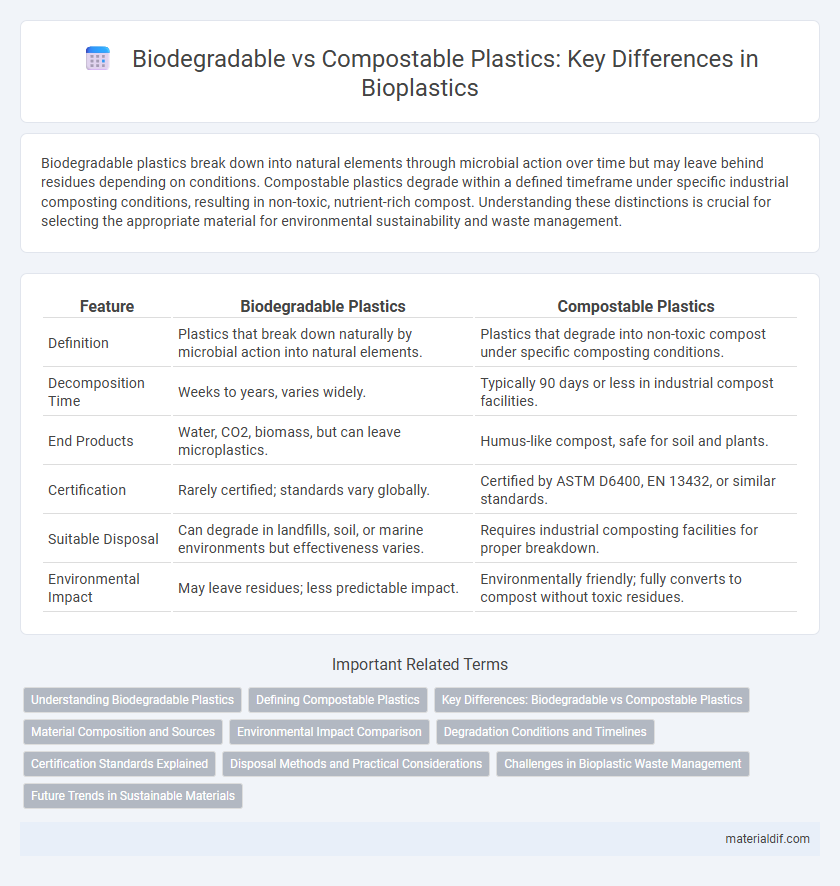Biodegradable plastics break down into natural elements through microbial action over time but may leave behind residues depending on conditions. Compostable plastics degrade within a defined timeframe under specific industrial composting conditions, resulting in non-toxic, nutrient-rich compost. Understanding these distinctions is crucial for selecting the appropriate material for environmental sustainability and waste management.
Table of Comparison
| Feature | Biodegradable Plastics | Compostable Plastics |
|---|---|---|
| Definition | Plastics that break down naturally by microbial action into natural elements. | Plastics that degrade into non-toxic compost under specific composting conditions. |
| Decomposition Time | Weeks to years, varies widely. | Typically 90 days or less in industrial compost facilities. |
| End Products | Water, CO2, biomass, but can leave microplastics. | Humus-like compost, safe for soil and plants. |
| Certification | Rarely certified; standards vary globally. | Certified by ASTM D6400, EN 13432, or similar standards. |
| Suitable Disposal | Can degrade in landfills, soil, or marine environments but effectiveness varies. | Requires industrial composting facilities for proper breakdown. |
| Environmental Impact | May leave residues; less predictable impact. | Environmentally friendly; fully converts to compost without toxic residues. |
Understanding Biodegradable Plastics
Biodegradable plastics break down through natural processes involving microorganisms, but the rate and conditions for decomposition vary widely, often requiring specific environments such as industrial composting facilities. Unlike compostable plastics, biodegradable plastics may not fully disintegrate into non-toxic residues, potentially leaving microplastics behind. Understanding these distinctions is crucial for waste management strategies and environmental impact assessments in sustainable plastic alternatives.
Defining Compostable Plastics
Compostable plastics are a subset of biodegradable plastics designed to break down into non-toxic compost under specific industrial composting conditions within a defined timeframe, typically 90 to 180 days. Unlike general biodegradable plastics that may degrade slowly or require specific environmental factors, compostable plastics convert fully into carbon dioxide, water, and biomass without leaving harmful residues. Certification standards such as ASTM D6400 and EN 13432 ensure these plastics meet rigorous criteria for compostability in controlled settings.
Key Differences: Biodegradable vs Compostable Plastics
Biodegradable plastics break down through natural processes over varying timeframes depending on environmental conditions, while compostable plastics decompose within specific industrial composting settings, leaving no toxic residue. Compostable plastics meet strict standards such as ASTM D6400 or EN 13432, ensuring complete breakdown into non-harmful substances like carbon dioxide, water, and biomass within 90 to 180 days. The main difference lies in the predictability and completeness of decomposition, with compostable plastics offering a certified, faster, and eco-friendly end-of-life solution compared to the inconsistent degradation of biodegradable plastics.
Material Composition and Sources
Biodegradable plastics are derived from both renewable biomass sources like corn starch and petroleum-based materials designed to break down through microbial activity over time. Compostable plastics, primarily made from plant-based polymers such as polylactic acid (PLA) or polyhydroxyalkanoates (PHA), decompose under industrial composting conditions into water, carbon dioxide, and biomass without leaving toxic residues. The distinct material composition influences their degradation processes, with compostable plastics requiring specific environmental factors for complete breakdown, unlike many biodegradable plastics that can degrade in diverse natural settings.
Environmental Impact Comparison
Biodegradable plastics break down through microbial activity but may leave harmful residues, whereas compostable plastics decompose into natural elements within a specific timeframe under industrial composting conditions, ensuring minimal environmental impact. Compostable plastics reduce soil and water contamination risks compared to biodegradable plastics, which can persist if conditions are suboptimal. Lifecycle assessments reveal that compostable plastics generally result in lower greenhouse gas emissions and reduced ecological footprint during degradation.
Degradation Conditions and Timelines
Biodegradable plastics degrade through natural processes involving microorganisms, but their breakdown timeline varies significantly based on environmental conditions such as temperature, oxygen levels, and presence of microbes. Compostable plastics require specific industrial composting conditions, including controlled temperature (around 58degC), humidity, and aeration, to fully decompose within 90 to 180 days. Unlike biodegradable plastics, compostable plastics leave no toxic residue and are certified to break down into non-toxic components within a standardized timeframe.
Certification Standards Explained
Biodegradable plastics degrade through natural processes but may leave microplastic residues, whereas compostable plastics break down into non-toxic components within specific industrial composting conditions. Certification standards like ASTM D6400 and EN 13432 verify compostability by assessing factors such as disintegration, biodegradation rate, and ecotoxicity. These certifications ensure compliance with regulated timelines and environmental safety, distinguishing compostable plastics from general biodegradable alternatives.
Disposal Methods and Practical Considerations
Biodegradable plastics break down naturally through microbial activity over time but may require specific environmental conditions to degrade effectively, often resulting in plastic fragments. Compostable plastics are designed to decompose fully into non-toxic components within industrial composting facilities, necessitating controlled temperature, humidity, and microbial activity for proper disposal. Practical considerations include ensuring access to suitable composting infrastructure for compostable plastics, while biodegradable plastics may persist in landfill or marine environments if conditions are unfavorable, affecting their environmental impact.
Challenges in Bioplastic Waste Management
Biodegradable plastics often require specific environmental conditions for effective degradation, posing challenges in waste management due to inconsistent infrastructure and unclear labeling. Compostable plastics demand industrial composting facilities with controlled temperature and humidity, limiting their decomposition in traditional landfills or natural environments. The overlap and confusion between these categories complicate collection, sorting, and processing, hindering efficient recycling and contributing to plastic pollution.
Future Trends in Sustainable Materials
Biodegradable plastics break down through microbial activity under specific environmental conditions, but may leave microplastic residues. Compostable plastics decompose fully into non-toxic components within a defined time in industrial composting facilities, promoting circular waste management. Future trends emphasize developing advanced compostable materials with enhanced performance and broader compatibility, driving global adoption of sustainable packaging solutions.
Biodegradable plastics vs Compostable plastics Infographic

 materialdif.com
materialdif.com